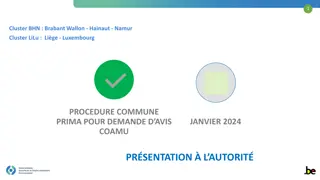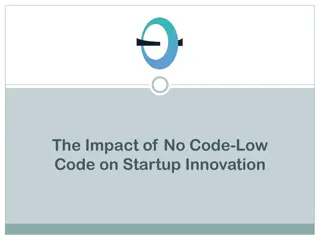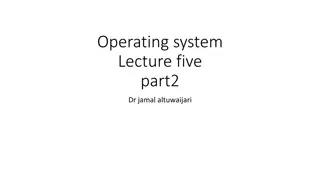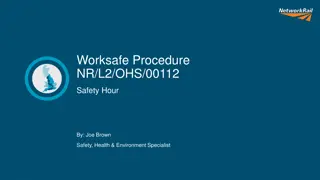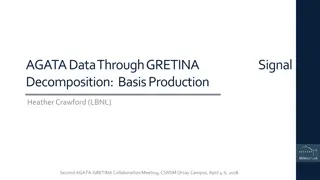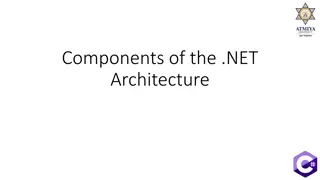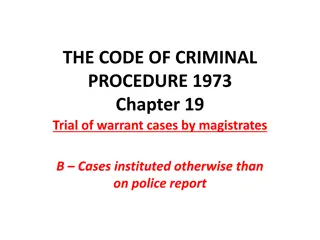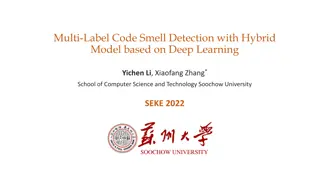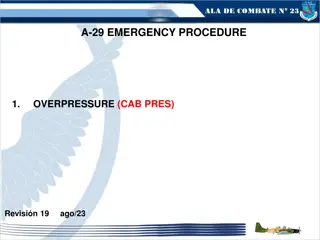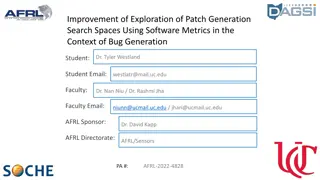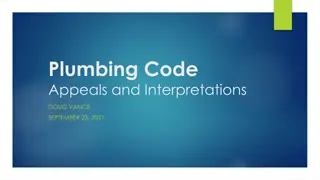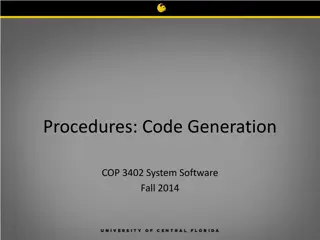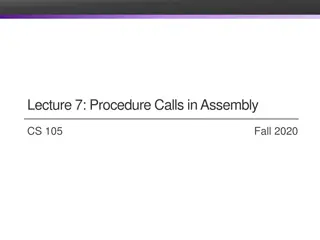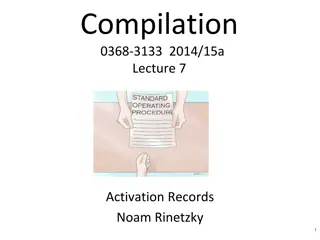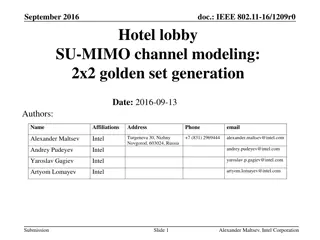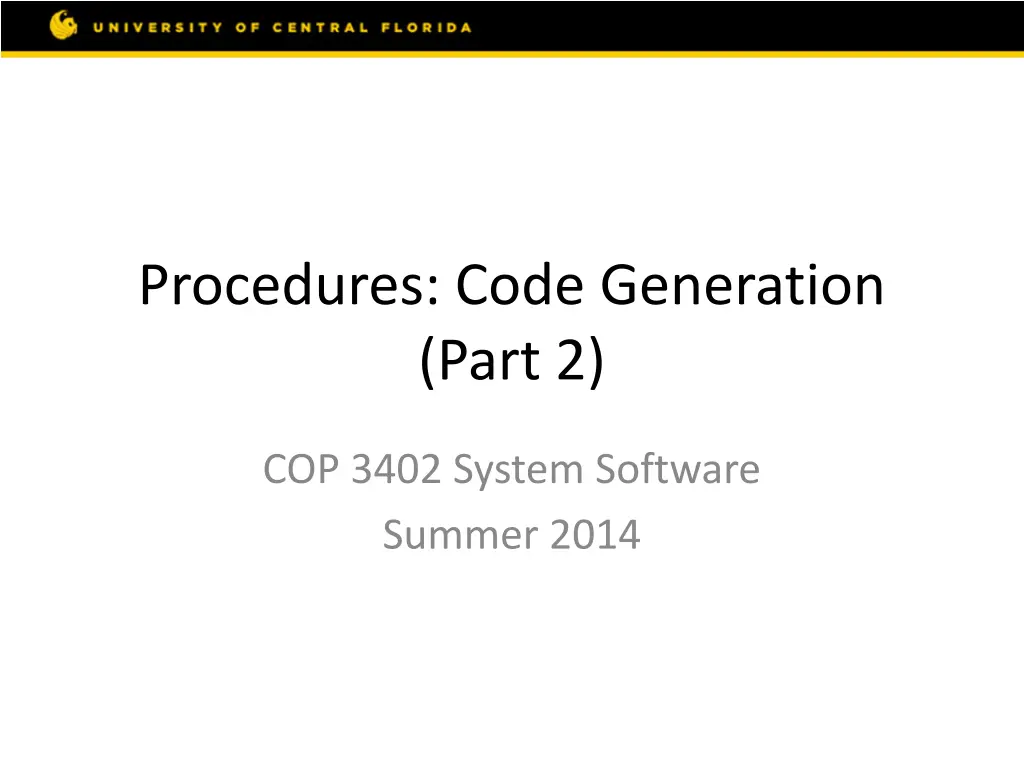
Procedure Address and Code Generation
Explore the use of address generation techniques for procedures in code development, including the use of JMP and INC addresses. Understand the implications of choosing between these addresses and how they impact program behavior. Dive into the details of procedure declarations and address updates to enhance your understanding of code generation processes.
Download Presentation

Please find below an Image/Link to download the presentation.
The content on the website is provided AS IS for your information and personal use only. It may not be sold, licensed, or shared on other websites without obtaining consent from the author. If you encounter any issues during the download, it is possible that the publisher has removed the file from their server.
You are allowed to download the files provided on this website for personal or commercial use, subject to the condition that they are used lawfully. All files are the property of their respective owners.
The content on the website is provided AS IS for your information and personal use only. It may not be sold, licensed, or shared on other websites without obtaining consent from the author.
E N D
Presentation Transcript
Procedures: Code Generation (Part 2) COP 3402 System Software Summer 2014
Procedure Address There are two possible addresses to use for a procedure: The initial JMP address The INC address 00 jmp 0 6 01 jmp 0 2 02 inc 0 5 03 lit 0 2 04 sto 0 5 05 opr 0 0 06 inc 0 4 07 cal 0 2 08 rtn 0 0 Both are valid to use, because the program will behave exactly in same way.
Procedure Address (JMP) Here, we use the procedure declaration to store the address of the procedure: procedure-declaration ::= { "procedure" ident ";" block ";" } procedure PROC-DECL; begin if TOKEN <> IDENTIFIER then ERROR() ; enter(PROCEDURE, ident, 0, level, NEXT_CODE_ADDR); GET_TOKEN(); if TOKEN <> ; then ERROR(); GET_TOKEN(); BLOCK(); if TOKEN <> ; then ERROR(); GET_TOKEN(); end This works because the first code instruction that block() generates is the JMP for this procedure.
Procedure Address (INC) If we want to use INC, then we must obtain the INC address from the BLOCK() function: procedure-declaration ::= { "procedure" ident ";" block ";" } procedure PROC-DECL; begin if TOKEN <> IDENTIFIER then ERROR() ; enter(PROCEDURE, ident, 0, level, 666); GET_TOKEN(); if TOKEN <> ; then ERROR(); GET_TOKEN(); proc_addr = BLOCK(); update(ident, proc_addr); if TOKEN <> ; then ERROR(); GET_TOKEN(); end bogus address Updates address in symbol table.
Procedure Address (INC) If we want to use INC, then we must obtain the INC address from the BLOCK() function: procedure-declaration ::= { "procedure" ident ";" block ";" } procedure BLOCK(); begin end; space = 4; jmpaddr = gen(JMP, 0, 0); if TOKEN = const then CONST-DECL(); if TOKEN = var then space += VAR-DECL(); if TOKEN = procedure then PROC-DECL(); code[jmpaddr].m = NEXT_CODE_ADDR; proc_addr = gen(INC, 0, space); STATEMENT(); gen(RTN, 0, 0); return proc_addr; Returns the INC address
Call To generate a call, we must verify that we re calling a procedure, and use the correct level: procedure STATEMENT; begin else if TOKEN = "call" then begin GET_TOKEN(); if TOKEN <> IDENT then ERROR (missing identifier); i = find(TOKEN); if i == 0 then ERROR (Undeclared identifier); if symboltype(i) == PROCEDURE then gen(CAL, level symbollevel(i), symboladdr(i)); else ERROR(call must be followed by a procedure identifier); GET_TOKEN(); end
Recursive Programs Consider this PL0 code: procedure fooA; procedure fooB; begin end; begin call fooB; end; begin call fooA; end. call fooA; What is going to happen if we generate code using INC addresses???
Recursive Programs Consider this PL0 code: procedure fooA; procedure fooB; begin end; begin call fooB; end; begin call fooA; end. Here, we enter the procedure into the symbol table using a bogus address (666). call fooA;
Recursive Programs Consider this PL0 code: procedure fooA; procedure fooB; begin end; begin call fooB; end; begin call fooA; end. Here, we enter the procedure into the symbol table using a bogus address (666). call fooA; And here, we generate a CAL operation using fooA s bogus address: CAL 0 2 666
Recursive Programs Consider this PL0 code: procedure fooA; procedure fooB; begin end; begin call fooB; end; begin call fooA; end. Here, we enter the procedure into the symbol table using a bogus address (666). call fooA; And here, we generate a CAL operation using fooA s bogus address: CAL 0 2 666 Here we know fooA sreal address, but it s too late, we already generated who knows how many wrong CALs.
Recursive Programs Using the INC address works in some programs, but fails for some recursive programs. Using the INC address for procedures is a lie!!! INC
Scope The scope of a symbol refers to where it is valid to use some given symbol. The scope begins with the symbol declaration. When the lexicographical level is less than the level at which the symbol was declared, the scope of that symbol ends. Variables declared at level 0 have global scope: can be used anywhere.
Scope A symbol can be used only after it is declared. 0 0 1 1 1 1 1 0 1 1 1 1 1 0 0 0 0 0 var a,b; procedure foo; var x; begin end; procedure lol; var y; begin end; begin call foo; b:=a; call lol; end. read x; a:=x; Access to: a,b,x,foo Access to: a,b,y,foo,lol y:=b; write y; Access to: a,b,foo,lol
Scope foo can t access lol: it has not been declared. 0 0 1 1 1 1 1 0 1 1 1 1 1 0 0 0 0 0 var a,b; procedure foo; var x; begin end; procedure lol; var y; begin end; begin call foo; b:=a; call lol; end. read x; a:=x; lol can t access x: the scope of x has ended. Main can t access x,y: both scopes have ended. y:=b; write y;
How to handle symbols scope? Using the Symbol Table! When the scope begins, add the symbol to the symbol table. When the scope ends, delete the symbol from the symbol table (it can t be used anymore). How to delete symbols depends on implementation, but here is one example.
How to handle symbols scope? Suppose that the symbol table is a simple array of symbols, where each new symbol is added at the end. 'symbol_table denotes the array of symbols. sx' denotes the amount of symbols in the symbol table. It starts at sx=0. Both are global variables.
Add a new symbol Just add the symbol at the end of the array. void enter(kind,name,val,level,addr){ table[sx].kind = kind; strcpy(table[sx].name, name); table[sx].val = val; table[sx].level = level; table[sx].addr = addr; sx++; }
Delete symbols When we leave level 1, we don t need the symbols declared at level 1 anymore. One option is to loop through the whole array, and delete the symbols with level 1 or more. Cumbersome: deleting arbitrary symbols from an array requires to move the symbols after it.
Delete Symbols Symbol Table 0 a 0 b 0 foo 1 x 0 0 1 1 1 1 1 0 1 1 1 1 1 0 0 0 0 0 var a,b; procedure foo; var x; begin end; procedure lol; var y; begin end; begin call foo; b:=a; call lol; end. read x; a:=x; y:=b; write y;
Delete Symbols Symbol Table 0 a 0 b 0 foo 0 0 1 1 1 1 1 0 1 1 1 1 1 0 0 0 0 0 var a,b; procedure foo; var x; begin end; procedure lol; var y; begin end; begin call foo; b:=a; call lol; end. read x; a:=x; y:=b; write y;
Delete Symbols Symbol Table 0 a 0 b 0 foo 0 lol 0 0 1 1 1 1 1 0 1 1 1 1 1 0 0 0 0 0 var a,b; procedure foo; var x; begin end; procedure lol; var y; begin end; begin call foo; b:=a; call lol; end. read x; a:=x; y:=b; write y;
Delete Symbols Symbol Table 0 a 0 b 0 foo 0 lol 1 y 0 0 1 1 1 1 1 0 1 1 1 1 1 0 0 0 0 0 var a,b; procedure foo; var x; begin end; procedure lol; var y; begin end; begin call foo; b:=a; call lol; end. read x; a:=x; y:=b; write y;
Delete Symbols Symbol Table 0 a 0 b 0 foo 0 lol 1 y 0 0 1 1 1 1 1 0 1 1 1 1 1 0 0 0 0 0 var a,b; procedure foo; var x; begin end; procedure lol; var y; begin end; begin call foo; b:=a; call lol; end. read x; a:=x; y:=b; write y;
Delete Symbols Symbol Table 0 a 0 b 0 foo 0 lol 0 0 1 1 1 1 1 0 1 1 1 1 1 0 0 0 0 0 var a,b; procedure foo; var x; begin end; procedure lol; var y; begin end; begin call foo; b:=a; call lol; end. read x; a:=x; y:=b; write y;
Delete Symbols Symbol Table 0 a 0 b 0 foo 0 lol 0 0 1 1 1 1 1 0 1 1 1 1 1 0 0 0 0 0 var a,b; procedure foo; var x; begin end; procedure lol; var y; begin end; begin call foo; b:=a; call lol; end. read x; a:=x; y:=b; write y;
Delete Symbols Symbol Table 0 0 1 1 1 1 1 0 1 1 1 1 1 0 0 0 0 0 var a,b; procedure foo; var x; begin end; procedure lol; var y; begin end; begin call foo; b:=a; call lol; end. read x; a:=x; y:=b; write y;
Delete symbols Symbols are inserted in order, with every symbol having the same or higher lexicographical level. When we delete symbols, we only do it at the end of the array. A better option to delete symbols is to just decrement SX by the right amount.
Delete symbols procedure BLOCK(); begin level++; prev_sx = sx; space = 4; jmpaddr = gen(JMP, 0, NEXT_CODE_ADDR); if TOKEN = const then CONST-DECL(); if TOKEN = var then space += VAR-DECL(); if TOKEN = procedure then PROC-DECL(); code[jmpaddr].addr = NEXT_CODE_ADDR; gen(INC, 0, space); STATEMENT(); gen(RTN, 0, 0); sx = prev_sx; level--; end;
Find symbols When symbols have the same name, resolving the scope could be a problem. var a,b; procedure foo; var a,x; begin read x; a:=x; end; begin call foo; b:=a; call lol; end. 0 a 0 b 0 foo 1 a 1 x Which a is the correct one to use? The one with the highest lexicographical level. The last one declared.
Find Symbols Return the last symbol found: int find(ident){ int index = -1; for(i = 0; i < sx; i++){ if(strcmp(table[i].name,ident)==0){ index = i; } } return index; }
Find Symbols Search backwards: int find(ident){ for(i = sx-1; i >= 0; i--){ if(strcmp(table[i].name,ident)==0){ return i; } } return -1; }



